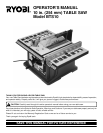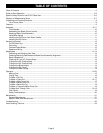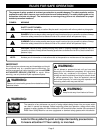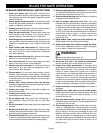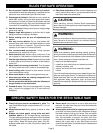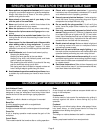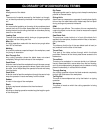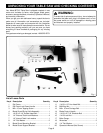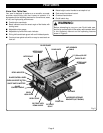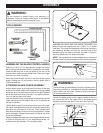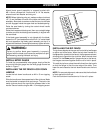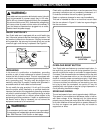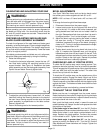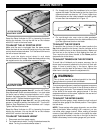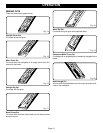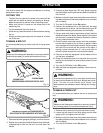
Page 4
RULES FOR SAFE OPERATION
1. Know your power tool. Read and understand the
operator's manual carefully. Learn the saw's applications
and limitations as well as the specific potential hazards
related to this tool.
2. Guard against electrical shock by preventing body
contact with grounded surfaces such as pipes, radiators,
ranges, refrigerator enclosures.
3. Ground your saw. Make sure that your saw is properly
polarized with an approved ground connection.
4. Keep the work area clean. Cluttered work areas and
work benches invite accidents. Do not leave tools or
pieces of wood on the saw while It is in operation.
5. Avoid dangerous environment. Do not use power tools
near gasoline or other flammable liquids, in damp or wet
locations, or expose them to rain. Keep the work area
well lit.
6. Keep children and visitors away. All visitors should
wear safety glasses and be kept a safe distance from
work area. Do not let visitors contact tool or extension
cord while operating.
7. Make workshop child-proof with padlocks and master
switches or by removing starter keys.
8. Do not force the tool. It will do the job better and more
safely at the rate for which it was designed.
9. Use the right tool for the job. Do not force the tool or
attachment to do a job it was not designed for. Use it
only the way it was intended.
10. Dress properly. Do not wear loose clothing, gloves,
neckties, rings, bracelets, or other jewelry. They can get
caught and draw you into moving parts. Non-slip footwear
is recommended. Also wear protective hair covering to
contain long hair.
11. Always wear safety glasses with side shields.
Everyday eyeglasses have only impact resistant lenses;
they are not safety glasses.
12. Protect your lungs. Wear a dust mask to keep from
inhaling fine particles.
13. Protect your hearing. Wear hearing protection during
extended periods of operation.
14. Do not abuse cord. Never yank cord to disconnect it
from receptacle. Keep cord from heat, oil, and sharp
edges.
15. Do not overreach. Keep proper footing and balance at
all times.
16. Maintain tools with care. Keep tools sharp and clean
for better and safer performance. Follow instructions for
lubricating and changing accessories.
17. Disconnect all tools. When not in use, before servicing,
or when changing attachments, blades, bits, cutters, etc.,
all tools should be disconnected from power supply.
18. Remove adjusting keys and wrenches. Form the habit
of checking to see that keys and adjusting wrenches are
removed from tool before turning it on.
19. Avoid accidental starting. Make sure switch is off before
plugging saw into power source.
20. Use the proper extension cord. Make sure your
extension cord is in good condition. Use only a cord heavy
enough to carry the current your product will draw. An
undersized cord will cause a drop in line voltage resulting
in loss of power and overheating. A wire gage size
(A.W.G.) of at least 14 is recommended for an extension
cord 25 feet or less in length. If in doubt, use the next
heavier gauge. The smaller the gauge number, the
heavier the cord.
21. Keep blades clean, sharp and with sufficient set.
Sharp blades minimize stalling and kickback.
22. Keep hands away from cutting area and the blade.
Do not reach underneath work or in blade cutting path
for any reason. Always turn the power off.
WARNING:
Blade coasts after being turned off.
23. Never use this tool in an explosive atmosphere.
Normal sparking of the motor could ignite fumes.
24. Inspect tool cords periodically. If damaged, have
repaired by a qualified service technician at an authorized
Ryobi Service Center. The conductor with insulation
having an outer surface that is green with or without
yellow stripes is the equipment-grounding conductor. If
repair or replacement of the electric cord or plug is
necessary, do not connect the equipment-grounding
conductor to a live terminal. Repair or replace a damaged
or worn cord immediately. Stay constantly aware of cord
location and keep it well away from the moving blade.
25. Inspect extension cords periodically and replace if
damaged.
26. Keep tool dry, clean, and free from oil and grease.
Always use a clean cloth when cleaning. Never use brake
fluids, gasoline, petroleum-based products, or any
solvents to clean tool.
27. Stay alert and exercise control. Watch what you are
doing and use common sense. Do not operate tool when
you are tired. Do not rush.
28. Check damaged parts. Before further use of the tool,
check any damaged parts, including guards, for proper
operation and performance. Check alignment of moving
parts, binding of moving parts, breakage of parts, saw
stability, mounting and any other conditions that may
affect its operation. A damaged part must be properly
repaired or replaced by a qualified service technician at
an authorized Ryobi Service Center to avoid risk of
personal injury.
READ AND UNDERSTAND ALL INSTRUCTIONS



